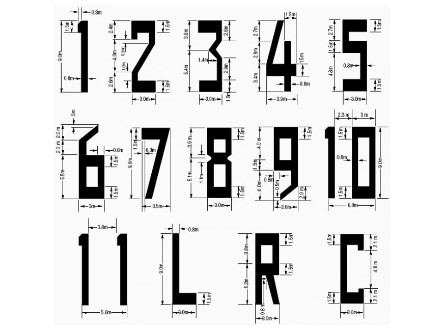

This included a new terminal building, a central tower, and two side buildings for arrivals and departures. This is called a demarcation bar, indicating that you are on a taxiway that is directly aligned with the end of an approaching runway.Jersey Airport was opened on 10th March 1937, and covered an area of 97 acres, with a 980-yard grass runway. In addition to all of the white runway markings, pilots will often come across yellow arrows, or yellow arrowheads along with a solid yellow line across the runway. What Does it Mean When the Markings are Yellow?
#RUNWAY NUMBERS AT EGJJ FULL#
White arrowhead chevrons can also be painted across the full width of the runway just before the threshold bar. Pilots know that a displaced threshold means that the runway’s length is less than what has been published.Īdditionally, a 10-foot wide threshold bar is painted across the full width of the affected runway just prior to the actual threshold, with multiple white arrows painted on the centerline between the displaced threshold and the runway’s beginning. The center stripe within a displaced threshold is arrow-tipped, directing the pilot to the nearby threshold.

This area of the pavement is called the Displaced Threshold, with specific markings to advise pilots. There are airports where the initial portion of a runway isn’t useable for landing, but it can still be used for takeoff rollout, or utilized for landing rollout when arriving from the opposite direction. There is also a threshold marking, indicating the beginning of the runway on all precision instrument runways, as well as on visual runways that are used, or intended to be used by international commercial aircraft. As runways get larger and more complex in their landing system capabilities they require more markings.Ī runway designator (number) and centerline are standard markings on all three runway types. Small runways used at municipal airports may only contain the runway designator. There are three types of runways that pilots will encounter during their flying years. * Identifying A Runway – How Do Pilots Get It Right? How Do the Markings Differ on the 3 Types of Runways? * How Do Pilots Know Where to Taxi Around an Airport? In the case of L, C, or R parallel runways, the letter is to be of the same height as the number and painted below (closer to the threshold) than the number. In compliance with ICAO standards, runway number designators are Arabic numerals required to be 60-63 feet tall and painted in white on a sharply contrasting tarmac of black or dark gray. To do this they are taught a particular way of annunciation by always sounding out each part of the designator, rather than saying “runway twenty seven”, or “runway twenty seven left”, etc. When communicating the name of a runway, pilots and air traffic controllers need absolute clarity in which runway is to be used. These are the most common markings most people see when looking at aerial photos of an airport. If you wish to find out more you can find the AC Here. There is more to runway marking than you may think so read on to find out just what many of these markings mean and how they are used to transfer information to the pilots.įor operations in the U.S., the FAA has published an Advisory Circular stipulating all the requirements that an airport must meet when marking its aircraft movement areas. Having a globally standardized marking system dramatically increased safety allowing pilots to instantly recognize the runway marking no matter which country they are operating in.

#RUNWAY NUMBERS AT EGJJ MANUAL#
Runway and airport markings are globally standardized in accordance with ICAO Annex 14, 5th Edition Aerodrome Design and Operations Manual to ensure every airport follows the same marking sizing, color, and layout conventions so pilots can instantly recognize where they can safely operate their aircraft. Accurate and well-marked runway designators benefit pilots during taxiing, takeoff, and landing. But when it comes to runway markings and numbers, there is worldwide conformity so that pilots, who are consistently crossing international borders, can’t tell the difference, visually, between runway 27L (two-seven-left) at Philadelphia International Airport and London’s Heathrow Airport, or at any other runway in the world with a 27L designator.

Global aviation can be incredibly complex, especially with each of the world’s 193 countries regulating the industry somewhat differently.


 0 kommentar(er)
0 kommentar(er)
